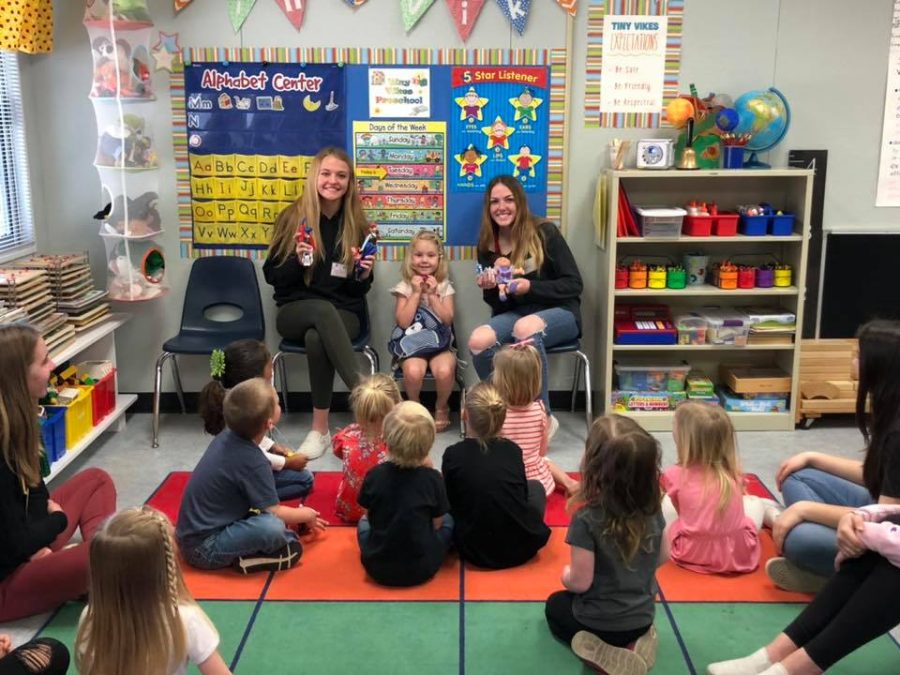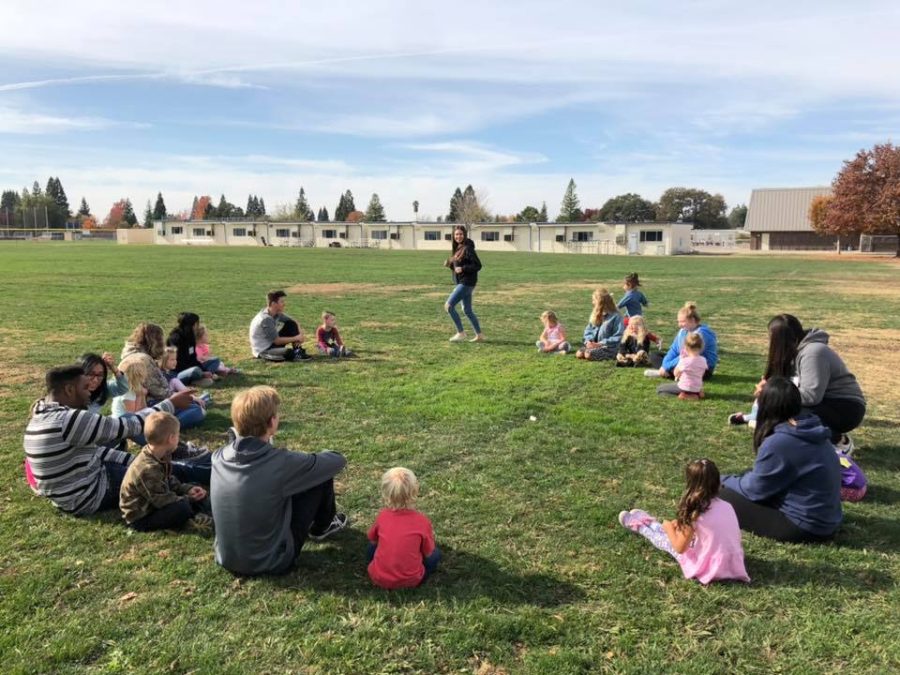Child Development: A Devastating Loss
Oakmont Vikings are still reeling with questions at the loss of the beloved program.
Oakmont Vikings are captured to be loving the Child Development Program.
December 22, 2021
Throughout high school, the daunting realization that the real world is approaching sooner and sooner sends panic throughout the campus. Ideally, students expect their high school years to be preparation for the real world.
Then why would such a vital and preparing course such as Child Development be extinguished and left in the dust?
Family and Consumer Science teacher Wendy Cox, currently teaching Culinary Arts, ran the Child Development program for 18 years before it was ultimately cut, its final year being the 2020-2021 school year.
“The class focused on birth through age 12,” Cox said. “We studied the physical, cognitive, social, and emotional development of children….we learned about parenting skills and the different kinds of parents out there.”
The class was a very unique offering brought to Oakmont’s campus, opening a whole new window of opportunities to students. A distinctive and eye opening aspect of the class was the Tiny Vikes program.
Tiny Vikes was the preschool Oakmont students ran for 2 hours a day, 3 days a week, for local families in need of a convenient preschool that would prepare their children for Kindergarten.
Jolie Geluck, Oakmont Alumni and current Oakmont IB Coordinator, spoke highly of the program as she had enrolled her children in Tiny Vikes.
“It was the curriculum you wanted your children to be exposed to, very play based,” Geluck said. “They loved interacting with teenagers.”
Yet this love wasn’t one sided, as the students were infatuated with working with the younger children, preaching their adoration for the class being a hands on based curriculum.
“My favorite part about the class was that it was so hands on,” senior Jolie Anderson said. “I feel like I really learned a lot.”
Having the ability to actually practice what they were learning and see how it was applicable to real life, was a vital piece in the class and its popularity.
“Being able to work with the kids one on one really gave you insight on how people develop from when they’re born to when they’re in high school,” junior Marissa Laucirica said.
Paired with the students’ love for the class, most were also able to identify how the curriculum was so beneficial for a vast variety of students on campus.
“A lot of people think the class is just helpful if you want to be a preschool teacher, but that’s not true if you want to work in any type of medical or sociology, or even if you want to be a parent of course,” Anderson said.
The class itself was quite common among students in the Heath Academy as it assisted them in solidifying which path in the medical field they desired to pursue, specifically whether it involved children or not.
The class not only benefited students looking into medical careers, but as Anderson said, those looking into careers in education.
“I took the class because I want to become a teacher for younger children when I am older,” junior Casandra Lawson said. “This gave me a realistic view into what that would be like so I could begin preparing myself.”
Lawson’s desire was shared by many as they wanted to expand their insight on what their ideal future was projected to be and if they were the right fit for it.
“I think it really helped [some students] realize that working with children was their calling and that they wanted to continue to work with children in some way,” Cox said.
This statement has, ironically enough, been proven by one of Oakmont’s very own.
“I took the class when I was a student here in the mid-90’s,” Geluck said. “It was one of the formative things in me deciding I wanted to be a teacher, that I wanted to do that with my career.”
With Oakmont being such a career prep driven school, Child Development fit well amongst the masses as it opened a whole new door to potential career paths for students on Oakmonts campus.
On top of this, another major piece in the popularity of the class was many students’ inclination to be a parent and have a family in the future.
“Taking care of the Real Care Baby helped them understand that the baby comes first,” Cox said. “Your life is not your own anymore, you come second to the baby.”
Many of us have witnessed students walking around campus with a baby carrier, passing estranged glances and whispers of confusion.
This was the infamous Real Care Baby project. Students would be required to take care of a realistic baby simulation doll for four days and three nights.
“I realized that being a parent is actually really hard,” Lawson said. “Children need a lot of attention, and they cry a lot, and they will not leave you alone.”
This project yielded students with a realistic view of what parenthood would be like, seeing how difficult caring for a child is.
It is evident how the beloved Child Development class was beneficial to the students of Oakmont campus, and how it was utilized to its greatest extent.
So why was this program cut?
Former Principal Robert Hasty, the ultimate decider in the loss of the program, identified how a major factor in the decision was the fact that Oakmont is downsizing.
“I think a piece that a lot of people don’t understand is that Oakmont is shrinking and will continue to shrink,” Hasty said.
The opening of West Park High School in the beginning of the 2020-2021 school year has rapidly decreased Oakmonts numbers, going from 2,200 students to a projected 1,400 next year.
With a school shrinking at an exponential rate, programs are going to have to be lost as there isn’t enough numbers, funding, and time to do everything.
“The pie is the pie,” Hasty said. “You can only do so many things. You can change around what you do, and what percentage of things you do, but you can’t do everything.”
This then presents the question of why was the Child Development program specifically cut?
As mentioned early, Oakmont as a whole is a very career prep driven school, meaning many pathways are set in place that consist of multiple levels to prepare students for certain fields of work. Some pathways present include that of Construction, Media, and the Health Academy.
“We wanted to make sure that the programs we maintained were programs that lead kids to something,” Hasty said. “What we would have seen was the Child Development Program become an education program that had child development courses, additional educational courses, and some sort of internship out in the teaching route.”
However it seemed as if there was simply a lack of interest by administration in developing the singleton class into something more.
“It would have been an education pathway, that’s what I proposed for years,” Cox said. “There was no interest in developing that pathway.”
Cox further divulged in what she had envisioned for the program to grow into over the years, even making genuine attempts at expansion.
“At one point I had a class called Field Experience, it was never a full class, just something I taught during my prep,” Cox said. “I was able to place kids at the daycare center across the street or at Crestmont Elementary as interns.”
Ideally, Cox hoped this Field Experience course and the Child Development course would be the kickoff for an education pathway to be developed, but the Field Experience class, a vital piece, was unfortunately cut.
“I did what I could, but a teacher cannot just create a class,” Cox said. “I was not supported in the development of the pathway, but then in the end, it was ‘you don’t have a pathway, you’re a singleton and so we can’t support you’.”
It is easy to sympathize with Cox over the loss of this program as it was unmistakable how much she loved the class and how proud she was to have seen it flourish into what it had become.
“I was hired to reopen the preschool and teach the class,” Cox said. “They gave me a box of books, some blocks, and a classroom. I made it into what was from there.”
The amount of time and energy Cox put into the program, growing it from the ground up, is admirable. So whilst Cox’s frustrations at the loss of the class were prominent, what ultimately shone through while discussing with her was her respect for the decision.
“All high schools are required to offer the core subjects, and the principal, this is their right, has the job to decide what pathways and electives are offered,” Cox said. “That is his prerogative.”
Even though at the end of the day it was Hasty’s word as to what came and went at Oakmont, it’s not as if the verdict was made lightly.
“Of my ten years at that school, it was one of the hardest decisions I had to make,” Hasty said.
Albeit the primary sources of the loss of the program have been identified, students are still voicing their frustrations with the decision.
“There are no other classes at Oakmont that can prepare students for a teaching career with younger children,” Lawson said. “Even if it wasn’t made into a pathway, the class as itself would have been so useful.”
Students relate to Lawson’s frustration as many are looking towards pursuing some form of a career in education. Why would Oakmont, such a career driven school, take an opportunity like this away from students?
Aside from being a preparing course for future careers, the class aided students with valuable skills for a pragmatic world.
“True, math is important, science, everything like that if you want to go down that field,” Laucirica said. “But in the end, most people want a family or end up having families. Those are the classes we need the most as they are so hands-on, they are real life stuff.”
This was the most prominent frustrations amongst the student body, that such a sobering course was lost. High school should provide students with skills that will actually be of use to them post-graduation regardless of what path they pursue.
Not every student will go on to college, not every student will chase a complex career path. But, every student will experience life.
This is why Child Development was viewed as such a revitalizing class. Students felt as if they were learning things that would be actually applicable to their lives at some point.
“I feel like in the future when I have my own family, I have a good idea of everything I need to know, how to prepare,” Laucirica said.
Oakmont should be striving for every student to feel like this is some form when they walk off of the campus forever and the loss of the Child Development program was not a step in the right direction.




